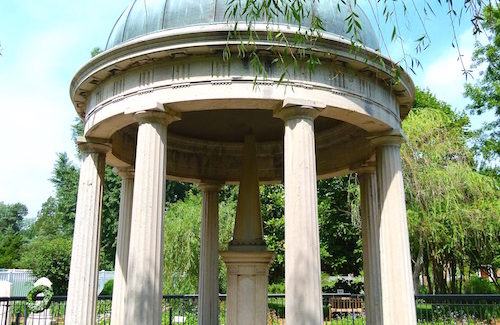Visiting Nashville: Andrew Jackson said to still walk the grounds of The Hermitage
Andrew Jackson loved his home so much that he chose to be buried there with his beloved wife Rachel. Some say that the man known as “Old Hickory” keeps watch over his Tennessee plantation.
“Many people don’t think that he has ever truly left,” tour guide David said. “General Jackson had such a strong personality that I think he has stayed around to watch over his home.”
The Hermitage is preserved today almost as it was during the days of the man who became an American icon. Built between 1819 and 1821, the home has almost all its original furnishings including the wallpaper, which dates to the early 1800s.
“If General Jackson were here with us, he would remember the home as it was the day when he left this world,” David said. “I see General Jackson as a rather sensitive spiritual person who loved his God, his country and his family and did what he had to do during very extraordinary times.”
THE BEGINNING
Jackson was born March 15, 1767, on the South Carolina border. His father died in a logging accident before Jackson was born, and the family had to move in with relatives to survive. Both of his brothers died in the Revolutionary War, and his mother died when Jackson was 14.
The penniless youth tried his hand at the saddlery trade and school teaching but was drawn toward the law and became a lawyer in 1787. Then he went to Nashville and found his future.
Staying in a boarding house, Jackson fell in love with the owner’s daughter, 21-year-old Rachel Donelson Robards who was trying to deal with a rocky marriage. Believing that her husband Lewis Robards had obtained a divorce, three years later Rachel and Andrew were married.
Then they found out that Robards hadn’t gotten a divorce after all. They were legally remarried in 1794, but the scandal plagued them the rest of their lives.
Jackson’s political star rose quickly, and the 37-year-old Jackson bought the Hermitage property outside Nashville during this time. Apparently, Andrew and Rachel Jackson couldn’t have children of their own, but they were always taking in other children to raise.
In 1806, an incident occurred that had a lifelong effect on Jackson. A dispute arose over payment when a horse sold by the Dickinson family came up lame. It escalated when Dickinson reportedly insulted Rachel. Finally, Charles Dickinson challenged Jackson to a duel. A well-known marksman, Dickinson shot first, seriously wounding Jackson who continued to stand his ground with a bullet lodged near his heart.
Jackson’s second demanded that Dickinson remain on his mark in accordance with the rules of dueling. Jackson shot Dickinson dead. Jackson survived his wound, although the bullet in his chest was never removed, and it compromised his health later in his life. The fight enraged many in Nashville, and Jackson was ostracized by much of Tennessee society.
THE WAR HERO
The War of 1812 gave Jackson a chance to save his somewhat tarnished reputation. Jackson racked up a string of victories that gained him a reputation as the country’s foremost commander in the field.
Then came the Battle of New Orleans. In 1814, Jackson and his ragtag army marched into New Orleans against the British. The British suffered more than 2,000 casualties. The Americans reported fewer than 20.
The victory confirmed the Louisiana Purchase, led to the acquisition of Florida, lent respect to the Monroe Doctrine and created a healthy regard for America’s independence. The victory also made General Jackson an instant legend and propelled him toward the White House.
But his past came back to haunt him – and eventually claimed his wife. The 1828 presidential campaign set a record for mud-slinging and name-calling. The worst attacks in the campaign were those on Rachel’s reputation, accusations of adultery and bigamy that hurt Jackson and his ailing wife.
Andrew Jackson won the election, of course, but Rachel never lived to be in the White House. Rachel died three weeks before the inauguration.
On Dec. 22, 1828, Rachel died, reportedly of a massive heart attack. Jackson blamed his wife’s death on the nasty campaign of 1828 and the stress of the imminent move to Washington.
On Christmas Eve, Jackson laid Rachel to rest in her white inaugural gown in the garden at The Hermitage, surrounded by weeping willows. Shrouded in grief, Jackson then made his way to Washington. For the next eight years, through two tempestuous terms in office, Jackson made his mark on the presidency and the nation.
One of the accomplishments that Jackson took the most pride in, David said, was the retirement of the national debt. For the first time – and so far, the last – in American history, the United States did not owe a single penny to anyone.
HOME AT LAST
In 1837, Jackson at last retired to The Hermitage at the age of 70. While in the White House, Jackson had a permanent temple made of limestone created for his wife’s grave and his own. The structure resembled a Greek-style gazebo. Lines from the epitaph he chose for her tombstone describes “a being so gentle and so virtuous slander might wound but could not dishonor.”
“Every day, he visited Rachel’s grave,” David said. “He missed his wife so much that he had a painting of her put in his bedroom so that she would be the last thing he saw at night and the first thing he saw in the morning.”
On June 8, 1845, the 78-year-old Jackson finally joined his wife in death. The former president died of kidney failure and was buried beside Rachel in The Hermitage garden.
But tales persist that General Jackson (as he liked to be called) often prowls the grounds – or rides them on his magnificent steed.
Story and photos by Jackie Sheckler Finch

















View Recent Comments